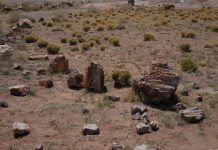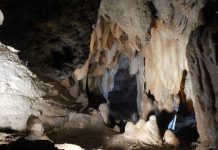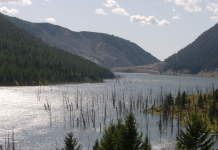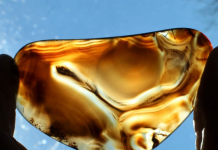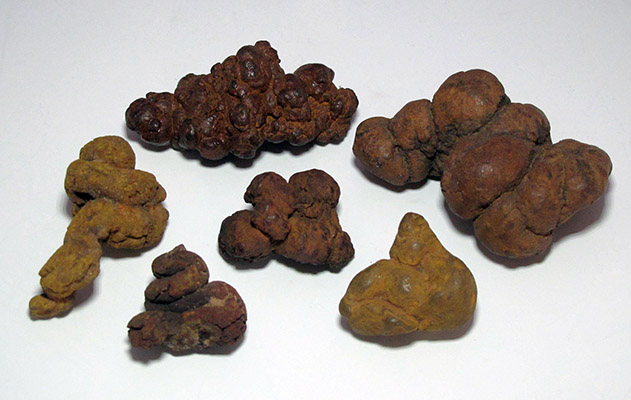
Story by Lori Carter
OK, coprolites are funny. How could rock-hard dino doo, fossilized feces, silicified scat, petrified poo, not be funny? They are the quintessential bottom line of rockhound potty humor jokes. But coprolites are more than just the butt of jokes. They are invaluable windows into the lives of long-gone creatures.
Mary Anning was a pioneering paleontologist who lived in Lyme Regis, along the “Jurassic Coast” of southern England in the early 1800s. While excavating the fossilized remains of ichthyosaurs and plesiosaurs, she observed distinctive conical objects in the vicinity of the animals’ abdominal regions. These objects were commonly known as “bezoar stones”, stony, indigestible gastrointestinal masses that can’t be expelled. People assumed the Lyme Regis objects were modern-day bezoars. Upon further examination, Anning noted that the peculiar stones contained fossilized fish bones and scales, as well as the fossilized bones of other animals. Based on these observations, she theorized that they were not bezoar stones, but the fossilized excrement of the ichthyosaurs and plesiosaurs.
Around 1824, Anning discussed her theory with William Buckland, an eminent geologist of that time. After further study of his own, Buckland concurred that the stones were indeed fossilized feces. He named them coprolites, from the Greek kopros (dung) and lithos (stone), and in 1829, he presented his findings to the Geological Society of London.

Many coprolites have decidedly poopy shapes. One of the easiest ways to identify coprolites is to compare their shapes to modern analogues. The spiral pattern observed on modern shark excrement is similar to certain marine coprolites. Crocodilian coprolites look almost “fresh”. Caterpillar frass coprolites in amber/copal are often identical to their modern analogues, leaving little doubt as to their nature. Modern ghost shrimp pellets are strikingly similar to coprolites found around decapod fossils. So, in some cases, we can use shape as a factor for identification with some certainty.
Shape would seem to be the most obvious way to identify a coprolite, but paleontologists have learned that morphology is not always conclusive. There are at least three other factors to consider: composition (physical and chemical), geology/stratigraphy, and associated fossils.
Buckland studied fossils found in Kirkdale Cave, located in Kirkdale, North Yorkshire. The cave contained hyena fossils and the fossilized remains of various mammals with marks consistent with gnawing. There were also some white rocks that looked like dried dog doo. Buckland postulated that hyenas dragged animals into the cave, where they could eat them. He even kept a few hyenas at his home so he could compare their feces to the rocks from the cave. Chemical analysis confirmed his suspicions: the white rocks in Kirkdale Cave had essentially the same composition as the modern hyena droppings.

Just as Buckland learned from the chemical analysis of hyena droppings, paleontologists have found that coprolites usually contain a lot of calcium phosphate. This aspect of coprolites actually led to the commercial mining of them. In 1842, a large deposit was discovered in England and a new industry was formed to capitalize on the high phosphate content. The phosphate was extracted and used to produce fertilizer. It is sad to consider all of the specimens lost to the phosphate industry. By the 1880s, coprolite mining had waned, but demand during World War I briefly revived the industry because phosphate was a critical component of the explosives used in munitions. Who knew fossil poo had a hand in the First World War (www.cambridgeshirehistory.com)?
According to Dr. Karen Chin, University of Colorado, Boulder, phosphate helps facilitate the replacement of the original material with minerals. Carnivore excrement naturally contains a lot of calcium phosphate from the bones of the animals consumed. Herbivore excrement may not have much calcium phosphate, so other sources of phosphates and minerals are needed. That is one of the reasons more carnivore coprolites are found than herbivore specimens—the carnivore excrement has a better chance of fossilization. Therefore, paleontologists look for the presence of phosphate when determining whether a specimen is a coprolite or not (David B. Williams, www.earthmagazine.org).
However, fully mineralized fossils may not have any trace of phosphate left. Or, phosphate may be present, but there are no traces of ingested organic material such as bones, shells, fish scales, seeds, bark, grass, leaves, etc. In these cases, a specimen is less likely to be a coprolite. The animal had to have eaten something to have pooped something out. One would expect some trace of what it ate, even in a fully mineralized form.
Geology and environment contribute to fossilization. Fossils are typically preserved under sedimentary conditions. Other conditions have the potential to preserve specimens; for example, a very dry environment, extreme cold, tar and resin (amber). So sedimentation is not an absolute requirement, but it definitely helps.
If the geology of an area shows no indication of past sedimentary processes, it was probably not conducive to the formation of fossils, but even sedimentation can result in misleading shapes. Although fossils can be preserved within a concretion, non-fossil-bearing concretions occur in almost any shape imaginable, often being mistaken as fossils, and that can be problematic when trying to determine whether a specimen is a coprolite or not.

The stratigraphy of the area is important. The layer in which Anning found her fossils has been identified as Jurassic in age. Other ichthyosaurs and plesiosaurs have been identified as Jurassic age, so it makes sense that they could have been the source of the Lyme Regis coprolites. If a specimen is found in a layer whose age is wrong for the suspected pooper, then identification becomes more complicated. For example, what if you found what appears to be a vertebrate coprolite in a Precambrian layer (which would be before vertebrates were known to exist). The specimen would have to have been displaced from a later layer to that one; it may not be vertebrate, or it may not be a coprolite at all.
Associated fossils, specifically other fossils found in the same area, indicate the past presence of organisms and may be clues to the maker of the poo. Sometimes, coprolites are found near the fossilized remains of the animal that pooped it. Tiny pellets are found in area in Mississippi known for fossilized decapods. Without decapod fossils for reference, it would be difficult to recognize the pellets as coprolites.
Spiral coprolites similar to some modern shark excrement have been found with shark fossils, so they were likely deposited by sharks. Smaller spiral coprolites have been associated with various fish, as well. For Anning, it was the occurrence of curious stones in association with ichthyosaur and plesiosaur fossils that led her to the idea of coprolites.
The lack of associated fossils does not prove conclusively that a specimen is not a coprolite, but it is an important factor to consider. Because excrement is relatively soft compared to animal parts like shells, scales and bones, it is less likely to be preserved. Also, it is much easier for the excrement to be squished, eaten, or weathered away before there is a chance for fossilization to occur. Since the odds are more in favor of hard parts being preserved, the odds are also more in favor of one finding fossilized hard parts. Even if the area was a prehistoric potty, one would expect to find some bones, shells, or other fossils in the area.

Size in relation to associated fossils is another consideration. Some coprolites are so big that entire vertebrae of the hapless animal consumed by the pooping animal are preserved. Insect coprolites have been found preserved in amber and in petrified wood. Invertebrate fecal pellets may become the nucleus of sand grain-size glauconite nodules. Ostensibly, large coprolites were excreted by large animals and vice versa. Anning found the fossils of various animals of different sizes. The first coprolites she found were large, so a commensurately large creature, like an ichthyosaur or plesiosaur, would be a logical source.
Yet, as with other identifying factors, one must consider size carefully. Dr. Tony Martin, of Emory University, Georgia, explains that coprolites found in the Morrison Formation in Utah are composed of many small pellets. The coprolites are probably from sauropods, which were very large creatures. Because the excrement likely had a high fluid content, the pellets merged together rather than scattering individually. He compares this to modern mule deer, also very large creatures, who excrete tiny pellets (www.envs.emory.edu/). Had the pellets fossilized separately, other factors would become even more important in linking the tiny coprolites to their source.
Following the research of others is also a good way to determine whether a specimen is a coprolite. If someone else has examined all of the factors available and has identified coprolites with reasonable certainty, then there is a high probability that a similar specimen found in the same area is also a coprolite. Amateurs usually do not have access to all of the diagnostic tools that a researcher or other professional has, so why not rely on their expertise?
If a specimen fails more tests than it passes, the odds are it is not a coprolite. One might argue that the composition of a specimen might not include phosphate or organic traces because the original poop has long since been replaced by other minerals. If some structure is still discernible, even in a mineralized form, then the specimen could still be a coprolite. But if all that is left is merely a cast of the original object, it is simply that: a cast. Just as one would consider the cast of a shell a trace fossil and not a fossilized shell, the cast of a coprolite would be a trace fossil, too; essentially, it would be a trace of a trace.
Consider an extraordinary copal specimen found near Mombasa, Kenya, along with some vertebrate fossils. Apparently, some feces was covered quickly by sediment, subsequent erosion revealed a void where the feces was, then resin filled the void and formed copal. Is the copal a coprolite? Most people would agree it is a cast and not a coprolite. Not that a cast of prehistoric poop would not be of any interest. It would still have significance, but without some indication of the original composition of the poop, its value as a scientific aid would be reduced to external morphology and associated fossils only. And without associated fossils, only the morphology would be of any value.

There is an ongoing debate about specimens from Salmon Creek in Washington. These specimens are composed of siderite. There is no phosphate, no organic traces, and no associated fossils. However, these specimens exhibit the most interesting aspect of coprolites—superb shape. They look like they were just pooped; so much so that their shape alone has convinced many people they are indeed true coprolites. Some specimens even have longitudinal striations that resemble markings made during excretion. Conversely, many people believe they are pseudofossils. There are equally convincing arguments from both sides of the debate.
Adolf Seilacher, a German paleontologist who has contributed significantly to ichnology (the study of trace fossils), along with Cynthia Marshall, H. Catherine W. Skinner, and Takanobu Tsuihiji, offer an explanation of the Salmon Creek specimens. “A fresh look at sideritic ‘coprolites’” was published in the journal Paleobiology (Winter 2001). Seilacher, et al. describe the specimens as “cololites” (feces preserved while still inside the animal’s gastrointestinal tract) that were “prefossilized [sic] by bacterial activity and later transformed into siderite with no traces of original food particles left.”
The authors also address the lack of other fossilized remains: “All occurrences are found within fluvial overbank deposits that carry no other vertebrate remains. Their absence could be due to aquifer roll-fronts that destroyed phosphatic bones and teeth but favored siderite precipitation.” Rather than excretion marks, longitudinal striations would be indicative of colon structure.
In the article “Enigmatic origin of ferruginous ‘coprolites’: Evidence from the Miocene Wilkes Formation, southwestern Washington” (Geological Society of America Bulletin, 2001), George Mustoe examines the controversial Salmon Creek specimens. In four hypotheses presented in the article, he cites the work of other paleontologists who studied similar formations where material was extruded in various ways: “coseismic liquefaction”, where material is forced up through cracks in rocks or sediment; “expulsion of sediment in response to gravity”, where material is forced down through cracks in rocks or sediment; intrusion through hollow logs, aka the “knot hole theory”; and methanogenesis, where methane gas released by decomposing organic matter has geologically “burped” the siderite into the coprolitic shapes. Mustoe concluded they are “pseudocoprolites produced by mechanical deformation of iron-rich sediment”.
Perhaps referring to the passionate views on both side of the controversy, Mustoe added, “However, the origin of these specimens remains clouded in mystery, and our best hope for arriving at a definitive explanation will come if researchers combine their search for new evidence with an open mind.”
Whether you consider Salmon Creek specimens to be coprolites or cololites or neither, there are undisputed examples of pseudocoprolites. Concretions of various compositions can have decidedly poopy shapes. Some botryoidal minerals, like hematite and goethite, can be mistaken for coprolites. Snakeskin agate may have the shape and crackled look of a coprolite, too. I even have some extruded plaster that fell a short distance and hardened into a perfect pseudocoprolite specimen.

So you think you’ve found a coprolite or you’ve purchased a specimen sold as a coprolite. Is it truly a coprolite? Unless you are a serious researcher or simply a purist, does it really matter? If you like it, enjoy it. Coprolites are fun. They are perfect for capturing a third grader’s attention, and they can even be incorporated into jewelry or carved and polished. Plus, there is much that can be learned from coprolites.
By studying the physical composition of coprolites, paleontologists can deduce whether the animal that produced it was most likely a carnivore, herbivore or omnivore. Traces of organic particles can help researchers determine what an animal ingested, which in turn helps determine where and when the animal lived. Seeds, spores, pollen, wood, grass, leaves, even microorganisms and parasites, can be preserved within a coprolite. Anning learned from bones she found in coprolites that ichthyosaurs had eaten other ichthyosaurs. She also found fish bones and scales, as well as belemnite remains in the coprolites that helped confirm ichthyosaurs were aquatic creatures.
If a coprolite can be linked to a potential pooper, the shape of the coprolite may provide clues to the contours of the internal structure of the digestive system of the animal. Shark coprolites and some fish coprolites are a good example of this. Buckland wondered if spiral ichthyosaur specimens were an indication that their intestines had spiral ridges. Without living ichthyosaurs to use for comparison, he injected cement into modern shark intestines. The shape of the resulting casts was similar to the ichthyosaur fossils. Because some of the ichthyosaur specimens Anning found were actually cololites and were preserved internally rather than being excreted, the experiment showed that ichthyosaurs probably did have spiral valves in their intestines, much like modern sharks (Gary L. Stringer and Lorin King, “Late Eocene Shark Coprolites from the Yazoo Clay in Northeastern Louisiana”, New Mexico Museum of Natural History and Science, 2012).
Conversely, coprolites with no shape can still provide helpful information about an animal. An amorphous coprolite could be indicative of a long fall ending in a splat or it could point to a high fluid content in the original feces that prevented a distinct shape, as in the sauropod coprolites from Utah. A lack of shape might be caused by trampling, decay, weathering, or even insects dining upon the fresh feces. Fish coprolites from the Lower Carboniferous Wardie Shales near Edinburgh, Scotland, are often found inside ironstone concretions that must be cut open to reveal the coprolite. The distinctive cracks around the specimens give them the appearance of squashed bugs, hence their nickname, “beetle stones”. The concretions obscure the shape of the coprolites, but the value of the coprolites is not diminished by their lack of original shape.
Despite the value of coprolites to paleontologists, many people are unaware that fossilized poop exists, and are surprised when they learn about it. But even people who are familiar with coprolites have never heard of related fossils that are important, too. Coprolites are just one of several trace fossils called bromalites, a term that encompasses fossilized material that came from the digestive system of an organism.
In addition to cololites, another bromalite preserved while still within the organism is a gastrolite (fossilized stomach contents). Gastrolites are not to be confused with gastroliths, also called “gizzard stones”, which are indigestible stones that were either swallowed by accident or were swallowed on purpose for ballast or to help crush food.
Regurgitalites (also regurgaliths) are fossilized vomit. Like gastrolites, regurgitalites contain food that was not fully digested. So, gastrolites and regurgitalites have components that are more easily identified, as well as components that are mostly intact. They are immensely helpful in determining what the organism ate.
It is important to note that, unlike regurgitalites and coprolites that, by definition, have exited the organism, gastrolites and cololites are more likely to be found in or near the organism. This makes associating the trace with the organism eminently possible and subsequently invaluable for research.
Another recently recognized and understandably rare bromalite is a urolite, a trace fossil caused by urination. Urolites are not fossilized urine, but soil deformations caused by urine hitting the ground. They are preserved in sediment the same way footprints and other track fossils are preserved.
So, in the fascinating study of trace fossils, coprolites and their kin may elicit some giggles, grins and groans, but they are also an intriguing piece of a paleontological puzzle for which we have tantalizingly few pieces.


